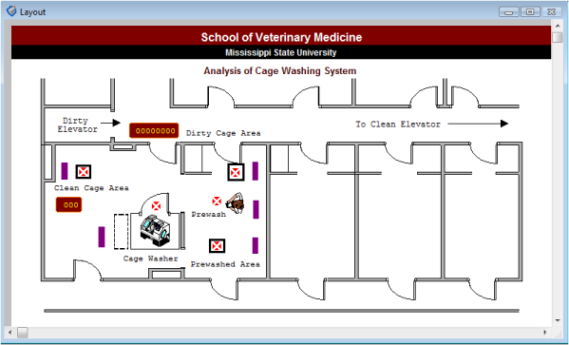New Cage Washer Helps Work Flow
September 21, 2010
 By Bonnie Coblentz
By Bonnie Coblentz
MSU Ag Communications
MISSISSIPPI STATE – Mississippi State University engineering students helped analyze work flow and equipment performance to document the need for new animal cage washing facilities, which were paid for by a federal grant of nearly $300,000.
Lucy Senter, director of Laboratory Animal Resources and the university veterinarian for MSU, was awarded the National Institutes of Health grant to purchase a new cage washer and to renovate the existing cage washing facilities. The new equipment and facilities will support veterinary research and clinical patients in MSU’s College of Veterinary Medicine.
“The cage washer is usually a very large piece of equipment found in most research facilities. Mechanically, it functions like a very large dishwasher to clean and sanitize large quantities of caging,” Senter said. “Typically, animal racks, rodent cages and anything else you need to wash in the cage washer can be effectively sanitized using this automated equipment.”
Along with buying the new cage washer, the NIH grant is paying to remodel the room housing the washer and rooms housing the clean cages. This will create a better traffic pattern and work flow. The university received the grant after proving the need to NIH.
“The students in industrial engineering analyzed how much our old cage washer was used, how frequently it broke down, and how feasible it would be to use an alternate cage washer across campus while our old washer was being replaced,” Senter said. “We submitted the information they gathered as part of our justification to NIH of why we needed a new one and why we should remodel our cage washing facility.”
Sandra Eksioglu, an assistant professor in industrial and systems engineering, was responsible for the students who analyzed the cage washing system. She said the students used the data they gathered and four years of data logs to build a computer simulation model of the processes involved with washing cages.
“The students were able to evaluate the performance of the old cage washing systems by using results from the simulation model, as well as using results from the statistical analyses of the data collected,” Eksioglu said. “Using the simulation model, the students demonstrated the benefits of having a new cage washer in the building and produced results that supported the request for funding to replace the old cage washer.”
Two student teams evaluated the process as part of Eksioglu’s class on systems simulation.
“The students provided results from a thorough statistical analysis of the data collected, and results from the simulation model demonstrated the time and money that would be saved if the old cage washer was replaced,” Eksioglu said.
Senter said the cage washer is a critical part of an effective animal husbandry program because it ensures that animals can be maintained in clean, uncontaminated caging.
The cage washer reaches a final rinse temperature of 180 degrees, hot enough to kill most pathogens that could contaminate the cages and the animals housed in them.
MSU has three cage washers; two are located in the veterinary college and one across campus in another laboratory. The main cage washer in the research wing of the veterinary college had gotten old and broke down frequently. Additionally, it had only one door, so dirty cages went in the machine and left sanitized through the same door.
Traffic flow into the cage washing facilities was awkward and did not completely separate the dirty side of the cage wash from the clean side.
“It’s better if you have a cage washer where the dirty items go in one door and the clean items come out another,” Senter said.
The new cage washer has been purchased and is being installed, with renovation work expected to be finished by the end of October.
Released: Sept. 9, 2010
Contact: Dr. Lucy Senter, (662) 325-0632
